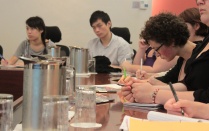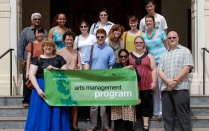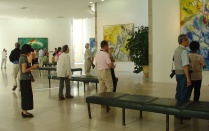
The world of arts management is led by hard working managers who strive to make the creative process and its results available to as many audiences as possible.
This is no easy trick given common constraints on talent and budget, complex policy requirements and changing economic and cultural environments in an increasingly borderless world.
Arts managers, however, in whatever field or country they choose to work, are crucial to the success of virtually every ballet company, rock band, orchestra, theatre, museum, gallery, community arts organization and arts policy agency in operation today.
The international and interdisciplinary Arts Management Program at the University at Buffalo devotes itself to the training and success of these managers, whether they eventually teach, operate in a desert on a shoestring budget or help to present world-class productions at a major institution in New York or Seoul.
This flexible, cross-disciplinary, theory-grounded UB graduate program is designed to meet the specific needs of every student. It offers exceptional instruction in management, cultural policy and diplomacy, governance, law, fund development and financial issues. It also places great emphasis on preparing students to anticipate and solve problems that affect all the disciplines involved in arts management.
“When they have the skills and know how to solve problems in this way,” says Administrative Assistant to the Director Kevin Leary, “they know they can operate effectively and successfully in any of a number of organizations, and overcome a wide range of obstacles.”
Students and graduates alike applaud the program’s small classes, world-class instructors, distinguished guest speakers and the opportunity to meet and work with national and international peers.

“ The UB Program helped me realize how important management is to collaborative enterprise like theater. The program highlighted the references, contexts, meanings, and technical languages of an arts organization. The program takes the perspective from all facets of an organization and makes clear what facilitates good management. ”
—Dan Shanahan, '11
Dan Shanahan is the artistic director of Buffalo’s refreshingly edgy Torn Space Theater, co-founded with associate director Melissa Meola. Its offbeat productions of avant-garde work are staged by a devoted team of artists, who neither coddle nor cuddle their audience.
These collaborations produce work that is strongly directed, visually stunning, sometimes violent, preposterous or grotesque, but always marked by a startling and effective use of sound, space and light. Torn Space presents challenging and controversial work by playwrights like Marsha Norman, Mark Ravenhill, Samuel Beckett, Ibsen, Pinter, Georges Bataille, Caryl Churchill and Shanahan himself.
Shanahan graduated with a degree in English from Buffalo State College in 2000. He now teaches theater at Buffalo State College and Daemen College, but Torn Space was his first artistic undertaking.
“It was an experiment that became a community of collaborative artists,” he says. “We’ve cultivated a loyal niche audience and become a very strong theatrical presence. But I was self-taught in running an organization, so I thought I’d acquire some formal education in my field.”
The UB graduate program appealed to him because its emphasis on academic inquiry and interdisciplinary studies promotes an understanding of arts management from many perspectives.
“The emphasis is on the theory, philosophy and law pertaining to arts management and less on the nuts and bolts of accounting, marketing, development and so on,” says Shanahan. “So a graduate can move comfortably between a number of arts organizations and apply these skills in each setting.”
Two other selling points were the flexibility UB offers to personally design the program according to one’s own goals, and its international summer learning experience.

“Students have been to Singapore, France, Germany and Scandinavia to meet and learn from the best in the business,” adds Shanahan. “I experienced the Venice Biennale, which was an intense and immersive time. One of the guest speakers was Pierre Guillet De Monthoux from the Copenhagen Business School, who has written about how to apply methods used by artists to improve leadership in management.”
Now back to his Torn Space work, he continues to lead his company in interpreting existing and original works, and designing often large-scale installation performances. Torn Space draws from the aesthetic traditions of sculpture, architecture and multimedia art. It employs such “theaters” as Buffalo’s massive mid-20th century Central Railroad Terminal; ruins of the Erie Canal beneath an elevated highway along Lake Erie; the grand ballroom of the almost century-old architecturally significant Dnipro Ukrainian Cultural Center; the massive, abandoned Marine A grain elevator on the Buffalo River; and Buffalo Polonia’s century-old, dark and intriguing Adam Mickiewicz Library and Dramatic Circle, which the company calls home.
“With all that I’ve learned at UB, I hope that I can further develop our audience and better support the individuals who have been so important to us,” says Shanahan.
What’s the program like?
Support the Arts and Sciences at UB

“ This has been is exciting and empowering work that will help me do what I’ve wanted to do for a long time: expand my theater’s programming, develop collaborations with other cultural groups and help extend, connect and develop my country’s art and theater communities. ”
—Steffany Irawan, ’13
Stefanny Irawan is a Fulbright Fellow and an instructor at Petra Christian University, a 50-year-old private, Christian university in Surabaya, East Java, Indonesia’s second largest city. She is an instructor in English and theater production and serves as managing director of the Petra Little Theatre (PLT).
The Petra Little Theatre lab was founded to assist students with English language and theater production skills, she says, but has expanded well beyond that role to present several plays a year, work with high school students and further develop its community audience.
“At PLT, since our work is grounded in English literature and English instruction, we attract our audiences with creative bicultural productions,” Irawan says.
Irwin has had a long affiliation with Petra Christian University, but says she needed an advanced degree in order to become a full-time faculty member. Because her interests developed in the direction of arts management–specifically theater management–the UB program appealed to her.
“UB offers a strong grounding in management theory, practical learning through the Fieldwork in Arts Management class, an excellent faculty, a practical, hands-on, immersive approach to learning and is designed to fit the individual needs and goals of its students,” she says.
Furthermore, Irawan learned strategies at UB that encouraged the kind of cooperation and partnering the arts environment demands in her country. She says Indonesia’s lack of a fully established system of arts leads those in the field of arts management to sometimes work with several organizations and with organizations outside a manager’s specific arts sphere.
“UB’s focus on theory and the philosophy of arts management has taught me how to uncover common issues among different organizations and art fields, and how to collaborate across disciplines,” she says. “I’m learning how, in specific aesthetic contexts, to produce the best possible art, discover the best circumstances in which to present it and find the best audience for the work itself.”
In addition to teaching and attending graduate school 9,000 miles away from home, Irawan is a translator and a prose writer whose work is found in Indonesian newspapers, magazines and in several anthologies. She also is the author of an elegant and critically well-received collection of short stories, “Tidak Ada Kelinci di Bulan!” (“No Rabbit in the Moon!”) (Gramedia Pustaka Utama, 2006).
Arts Management Program Summer School

“ My goal is to be in the business of performance and someday open a not-for-profit performing arts center myself. The UB Arts Management Program is helping me use my business education to accomplish my artistic and educational goals. It is exactly what I need and it has been a wonderful experience. ”
—Dominique Miller, ’13
Dance, managerial economics, cultural studies, interdisciplinary performance, statistics and arts education are just a few of Dominique Miller’s interests. In undergraduate days at the University of California, Davis, she majored in African American studies and minored in statistics and managerial economics.
It was as a dancer and as president of the university’s Black Repertory Theater Group, however, that Miller says she began to wonder how she could marry her deep love of the arts and her business training in a way that would benefit underserved communities.
“My goal is to be in the business of performance and someday open a not-for-profit performing arts center myself. The UB Arts Management Program is helping me use my business education to accomplish my artistic and educational goals. It is exactly what I need and it has been a wonderful experience.”
In high school, Miller studied with performers like choreographer and actress Debbie Allen, whose programs extend the availability of dance and theater to young people. Miller says she has always been excited by the way art inspires people, but by working with Allen she realized a desire to produce opportunities for audiences to experience the transformative power of the arts.
Miller particularly enjoys the arts management program’s strong international focus, which includes study with Katja Praznik, a sociologist of culture and former dramaturge, who brings a wealth of personal and international experience to the program.
“She also works with Miriam Paeslack, an art historian, photographer, theorist and author trained in Germany, Italy and the U.S.,” says Miller. “The UB program has given me exposure to people and places I might never have met, never have known: instructors, lecturers, program directors, my fellow students from the U.S. and abroad. It has helped me focus my goals and to work with experienced professionals to accomplish them.”
Miller also had the opportunity to interview Leslie Johnson, director of education and community partnerships at the Center Theater Group in Los Angeles for one of her UB projects. Johnson recommended that Miller participate in the UB Arts Management Program’s summer study in Singapore.
“That experience, along with my relationships with international students in the program, really broadened my understanding of this field,” she says.
Today, as she finishes her degree, Miller works as the education coordinator for Young Audiences of Western New York. This widely heralded not-for-profit arts agency offers hundreds of programs, workshops, residencies and assembly performances throughout the eight-county Western New York region. Its goal is to reinforce curriculum topics, foster creative and critical thinking skills and broaden student understanding of the world’s arts and cultures.
“Through a National Endowment for the Arts ‘Our Town’ grant, we’re working with Buffalo schools and local organizations serving large populations of immigrant families and K-12 students from various countries," Miller says.
Program affiliations with other UB departments, schools and programs

“ I attended the program’s summer school in Singapore, where I met and spoke with the co-founder and director of Intercultural Theatre Institute; the education director of the Hong Kong Arts Festival and the general manager of Singapore’s Intercultural Theatre Institute. ”
—Faruh Kuziev, ’12
Faruh Kuziev’s enthusiasm is contagious and productive.
He came to UB after serving for several years as the executive director of the multifaceted Bactria Cultural Center in the Tajik capital of Dushanbe. It was established in 2001, following the country’s devastating civil war and it remains of great importance in the artistic and cultural development of Tajikistan.
“Bactria promoted the role of artists as creative and intellectual leaders of Tajik communities,” Kuziev says. “We collaborated with local artists to present exhibitions, edgy film series, music festivals, workshops with visiting artists and free seminars for students – plus we provided vocational, language and computer training.”
He began at Bactria as a translator but decided that his future was in arts management. He had experience but no formal training in the field, so he applied to the Fulbright Foundation for assistance.
“What appealed to me about the UB Arts Management Program,” he says, “was that it presents arts and arts management as extremely important manifestations of human life and culture. The faculty members were outstanding in so many ways. They were my major source of knowledge and the keys to my growth and progress.”
Kuziev cites program founder Ruth Bereson, in particular, as well as noted arts manager Patrick Fagan, who taught the course, “Why Manage the Arts?”
“To this day, I repeat his words to myself and others and recognize that his way is the way arts management should operate,” he explains. “He told us, ‘The way you control the future is by creating it,’ and that is how I continue to operate. If I need a job, I don’t look for one, I create it. If I need a change in the art scene around me, I don’t wait for it. I design the change and lead my community to it.”
Kuziev also cites UB faculty members Julian Meyrick – “one of my favorite professors of all time” – for helping students understand cultural policy through the use of narratives. And others, who helped him learn to advocate for small arts organizations through legal and communication methods.
When he returned home in September 2012, Kuziev co-founded Dushanbe Art Ground. He serves as the organization’s artistic director, fundraiser and development director. Art Ground has housed screenings of award winning films by young Tajik directors. He also began an artistic research project called “Modalities” that gathered young intellectuals, activists, writers and gender professionals to reflect on gender issues in Tajikistan though art. The center then presented three visual, audio, performance and drama works on this theme.
Photos by Lukia Costella and Doug Levere





